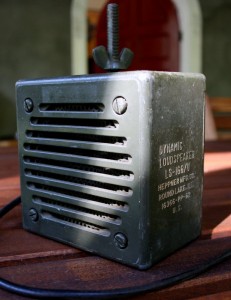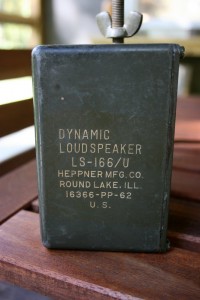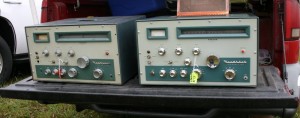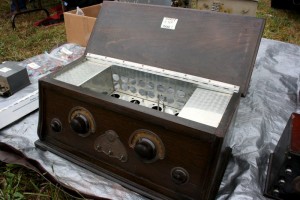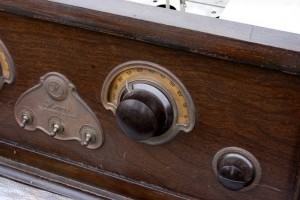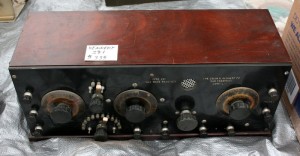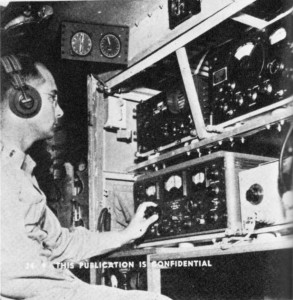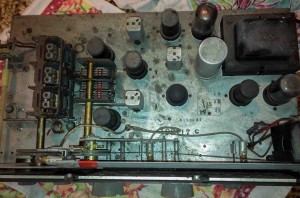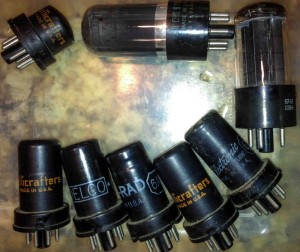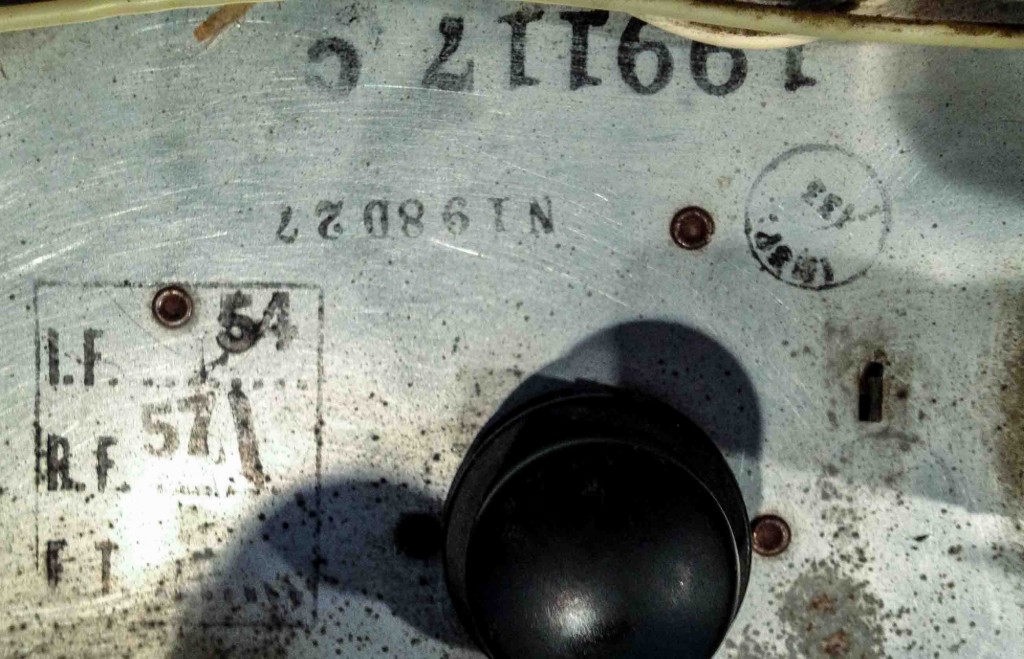If you like military radios as much as I do, you’ll love this video of Andy’s (GW0JXM) R1155 WWII era military HF receiver:
Hat tip to my good friend, Mike, for sending this video!
Category Archives: Boat Anchors
Try that with an iPhone!
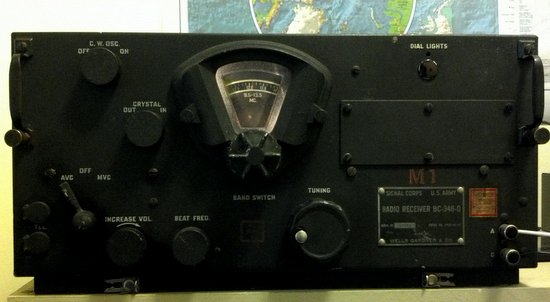
With the help and guidance of my good friend Charlie, we just repaired and aligned this BC-348-Q receiver. BC-348s were built to withstand the extreme temperatures (-60F) and vibrations on board the B-17 and other bombers, where they were used extensively in World War II. I picked this beauty up at the 2012 Dayton Hamvention for $40.
Next year, this radio will be 70 years old.
This morning, I have it tuned to Radio Australia’s Saturday Night Country on 11,660 kHz shortwave. It’s “connecting” to a wireless network over 9,800 miles away and producing beautiful, warm audio.
Try that with an iPhone.
The Ten-Tec Hamfest–and my new (vintage) LS-166/U military loudspeaker
This past weekend was the Ten-Tec Hamfest, which is held each year at the Ten-Tec factory in Sevierville, Tennessee, USA. I’m particularly fortunate in that I live within a few hour’s drive of the factory, so I make it a point to attend the Hamfest each year.
Hamfests, for those of you not familiar with them, are basically flea markets or swap-meets for amateur radio operators and radio enthusiasts of all stripes. It’s a place to reunite with hobbyist friends and to trade, sell, or purchase new or used radio equipment. The Ten-Tec Hamfest is free, draws a sizable crowd, and what’s more, attendees get the opportunity to try out Ten-Tec radio equipment and tour the factory where their products are made. The Hamfest also coincides with the annual SEDCO DXer/Contester Conference, which is held in the same town, and begins just as the Hamfest winds down.
This year, I had not intended to buy anything. Still, I’m pleased to admit I bought only one item…
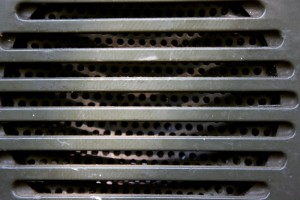
The LS-166/U loudspeaker is built like no other–it’s even gun blast resistant! Its rigid cone is well protected by thick metal screen and mesh.
My purchase: an LS-166/U loudspeaker. This small speaker has been used extensively in military operations around the world. It’s built like a tank, was perhaps mounted in some, but used primarily used in Jeeps, trucks, and on portable radio packs. The case is made of metal and extremely durable. The two watt speaker has a permanent magnet. It is also fungus, gunblast, and immersion resistant: if you drop this speaker, you don’t need to worry about damaging it–rather, you may need to worry about the floor (or your foot).
The really cool thing about this speaker is that it contains an audio transformer that–via a switch on the side–will allow you to chose between a 600 ohm primary and 8 ohm secondary impedance. The speaker sounds crystal clear, even though mine has obviously received extensive usage. That’s the great thing about military gear–it was designed for functionality, often over-engineered, and certainly built to last!
The LS-166/U is not for listening to music–it was designed primarily for radios that require a high impedance load, and for voice audio clarity. If you’re receiving orders over the radio from your commander, the LS-166/U will punch through the noise from your vehicle and surroundings. It sounds “tinny” if used to listen to shortwave broadcasters, but is actually quite effective when used to listen to amateur radio transmissions and morse code. The 300 Hz to 7 kHz frequency response is ideal for this type of application.
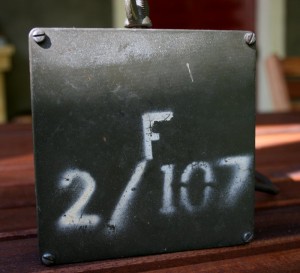
The schematic is printed on the inside of this back plate, which is easily removed with a plain head screw driver
The first rig I hooked up the LS-166/U to was my Hammarlund SP-600, which has a 600 ohm output. Though I know I can hook up a larger, more responsive speaker for better fidelity, there is something rewarding about hearing a speaker that has seen so much service being used once again, and still playing as if new.
As you can see from the photo below, mine lacks the knob on the side of the case. I’ll be looking for one of these at the next Hamfest–or may just order one from Fair Radio.
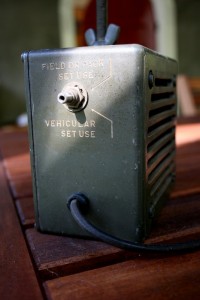 If you happen to locate the LS-166/U loudspeaker at your local Hamfest, grab one! There are a lot of them floating around and they’re usually quite affordable–typically between $10-20 US (more if mint). I was lucky to pick mine up for $4. Not only is it an affordable piece of military radio history, but I think it would make an excellent external speaker for amateur radio use during outdoor events like Field Day. Indeed, I think this speaker will weather any radio challenge!
If you happen to locate the LS-166/U loudspeaker at your local Hamfest, grab one! There are a lot of them floating around and they’re usually quite affordable–typically between $10-20 US (more if mint). I was lucky to pick mine up for $4. Not only is it an affordable piece of military radio history, but I think it would make an excellent external speaker for amateur radio use during outdoor events like Field Day. Indeed, I think this speaker will weather any radio challenge!
So, what else did I see at the Ten-Tec Hamfest this year? Quite a few classic receivers. Though I didn’t take many photos, I did snap a few gems…
Photos
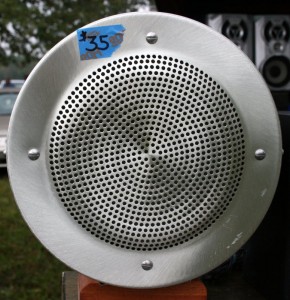
This aluminum radio speaker reminds me of the external speakers found on radios in the early 1900s. The seller had made a custom wooden base for this one (click to enlarge)
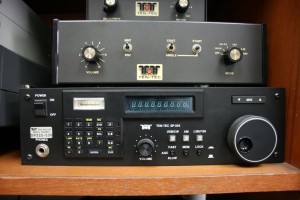
If you visit the Ten-Tec factory, tour their radio museum, housing nearly every radio Ten-Tec has produced. One example is the SP-325 (on bottom) a shortwave receiver which once served the US government as a training radio. They’re fairly rare, but can be found occasionally on eBay. (click to enlarge)
Gizmodo: “shortwave radio deserves a place of prominence in the home of any audiophile”
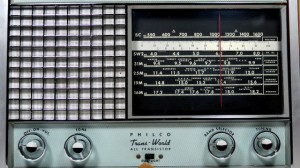 (Source: Gizmodo)
(Source: Gizmodo)
Classic turntables may get all the glamour, but the shortwave radio deserves a place of prominence in the home of any audiophile. For a stylish way to surf the airwaves, try this stunning late 1950s Trans-World T-9, produced by Philco (that’s the Philadelphia Storage Battery Company, for those who don’t like to abbreviate).
[…]Its four-foot antenna can pick up tunes, blast right-wing talk radio, or catch up on the endless, mysterious recitation of Russian numbers.[…]
Though this article points to eBay auctions–which, in truth, tends to favor the seller, price-wise–they make a point: classic radios deliver audio fidelity that, in my opinion, surpasses all modern portables.
The connection between Hallicrafters and 1940s electronic warfare
One of my favorite ham radio blogs is that of John (AE5X). Like me, he’s a QRPer–meaning, as amateur radio operators, we love making contacts across this great globe of ours using very low power…typically 5 watts or less. The challenge is fun, the medium is magical.
John’s also a radio historian and shortwave radio listener. Yesterday, he posted a most fascinating look at how the Hallicrafters S27s played an important role during World War II countering very innovative radio guidance techniques by the Third Reich.
You should bookmark John’s blog, as he post many radio related topics that the SWL would find enjoyable, whether it be about numbers stations, QSLs or even his own experience learning Russian via shortwave.
But first, read: Hallicrafters and electronic warfare in 1940 on 10 meters. . .or, an ‘Aspirin’ for the ‘Headache’
Jeffrey revives an old friend, his Hallicrafters SX-110
SWLing Post reader, Jeffrey Fritz, sent me the following message and has kindly allowed me to share it with other readers. I’mthoroughly inspired!
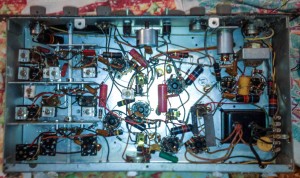
Bottoms up! Considering how old this receiver is, the chassis bottom (still with the original power cord) really is clean. This is how the bottom of the chassis looked when I removed the receiver from its metal cabinet.
As a teenager in the 1960s I spent a considerable amount of time SWLing on a Hallicrafters SX-110 communications receiver. I collected QSL cards from all over the world and loved being an SWL.
The SX-110 was purchased on 9 September 1961 from Gem Electronics in Farmingdale, Long Island, New York. My parents bought it for me, probably after a great deal of whining and cajoling on my part. Although much of my gear has long since been sent to some landfill by my parents, like my precious Lionel trains, I would not allow them to trash the SX-110.
The radio has been sitting in one basement or another, unused for the better part of 30 years.
Yesterday I decided to try bringing the radio back to life. Restoring this kind old receiver was a labor of love. The receiver was carefully looked over and tested with a VOM for bad components and the top of the chassis cleaned as best I could. The bottom was pristine. I just needed to clean out a few cobwebs and replace the power cord.
After being cleaned up and several components tested, the SX-110 was slowly brought back to life on a Variac. I started at 10 volts AC and slowly increased the voltage every ten minutes by another ten volts. When I got to about 90 VAC, I could hear static and distorted audio coming out of the speaker. It was a good sign that the radio would come back to full operation once I reached the normal 110 VAC input–and that is exactly what occurred.
I am happy to report that, with a little patience and love (and a good cleaning) –and with three of the original Hallicrafters tubes still in place, my trusty old Hallicrafters SX-110 shortwave receiver is happily working today. I have it connected to its original Hallicrafters R-47 3.3 ohm speaker.
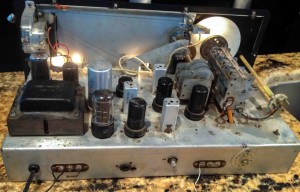
The top chassis is cleaned as much as possible. Not perfect, but a little cleaner than before. We now have about 110 volts applied through the Variac. No smoke but we do have lights!
Yesterday evening I listened to Radio Taiwan, Radio China International, Radio Havana Cuba, The Voice of Turkey and The Voice of Russia. The audio quality was rather decent without a hint of AC hum. The radio is probably due for a good alignment. I am running the radio on the Variac set at 110 volts AC and will probably keep it on the Variac because the AC voltages today in the U.S. are significantly higher than they were in 1961.
Even the XYL thinks that the radio sounds terrific! What better recommendation can there be for this old, vintage receiver?
73, Jeffrey Fritz, WB1AAL
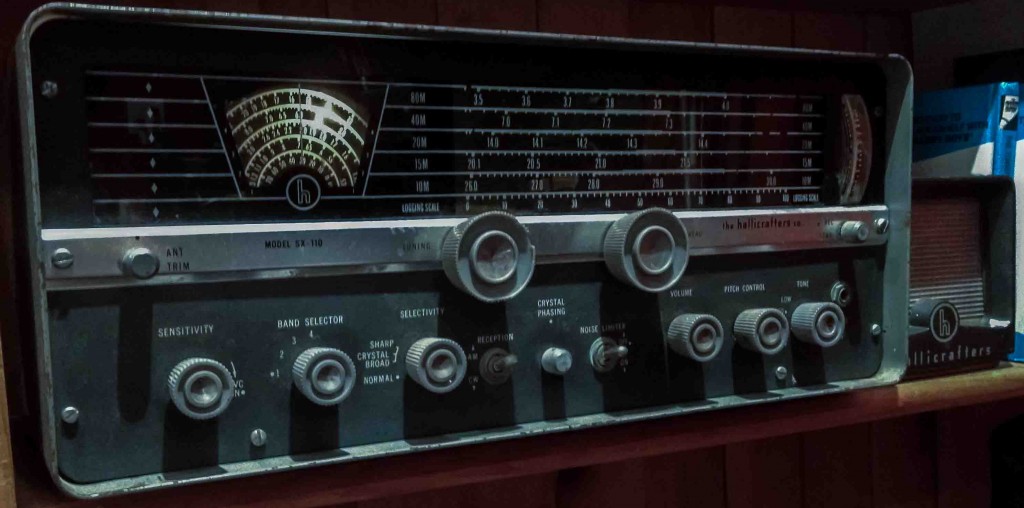
The restored SX-110 sitting on the bookshelf in the shack. No one would mistake this for a new receiver, but it works just fine.
PS–Jeffrey also mentioned to me: “If you look closely at the chassis stamp photo of the SX-110, you can see a stamp that reads ‘199117 C.’ This is the manufacture date of the receiver. The fourth digit is the year, and the fifth and sixth digits are the week of the year. So, 199117 is the 17th week of 1961 or the week of 23 April 1961.”
Very interesting. Now I need to examine a few of my own Hallicrafters receivers…

